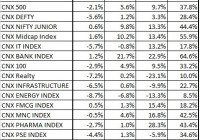Tag Archives: india
Tsunami Of Level 1 Indian ADRs Expected In U.S. OTC Markets
Summary The Indian finance ministry has allowed the issuance of sponsored and unsponsored Level 1 ADRs. DRs can be issued against any underlying permissible security such as equity, corporate debt, mutual funds, ETFs etc. Provides an exciting opportunity for overseas investors to invest in the Indian growth story. What are unsponsored ADRs? There are 4 types of American depository receipts, in increasing order of regulatory requirements: 1. Unsponsored ADRs 2. Sponsored Level 1 ADRs (OTC) 3. Sponsored Level 2 ADRs (listed) 4. Sponsored Level 3 ADRs (offering)… these were the only type of ADRs available for Indian companies. They have the most stringent regulatory requirements Level 1 and Level 2 ADRs have less stringent requirements than Level 3 ADRs, but all of them are sponsored (issued) by the issuer. In contrast, an unsponsored ADR is one in which there is no deposit agreement and no legal relationship between the depository bank and the issuer. There are no regulatory disclosure requirements for the issuer to comply with the Sarbanes-Oxley and no requirement to adhere to US GAAP requirements. In fact, an unsponsored ADR can be issued without the consent of the issuer. These instruments can be traded in the over-the-counter (OTC) markets in the United States. During the Union Budget of July 2014, Arun Jaitley, India’s Finance Minister, had accepted the Sahoo Committee’s recommendation for liberalization in ADR/GDR issues. As per the new Depository Receipts Scheme, a foreign depository bank is permitted to issue unsponsored ADRs for the first time. Since that announcement, BNY Mellon (NYSE: BK ) has confirmed that it has filed with the US SEC to establish several unsponsored depository receipts program from India. The proverbial home bias A US investor is more likely to invest a large proportion of his investments in domestic equities. This is mainly due to their familiarity with local regulations and settlement procedures. Also their investment mandate may force them to invest in only USD-denominated stocks. However, portfolio theory states that there are significant diversification benefits from investing in foreign equities as it lowers systemic risks from domestic factors. The credit crisis of 2007 and the various currency crisis that continue to occur over time shows that contagion spreads during a crisis. And the benefits of international diversification are considerably reduced during times of stress. But aside from these “Black swan events,” investment in foreign equities is likely to provide direct exposure to high-growth companies in emerging markets. What does it mean for investors in the US? Indian bourses have given returns in excess of 30% in the last one year. This has been on the back of positive sentiments arising due to the new business friendly prime minister. Also as per the latest economic indicators, it is likely that the economy is on a recovery path. This could lead to a multi-year bull run, similar to one seen in the US stock markets. In light of these very favorable circumstances, the announcement by the Indian finance minister to liberalize the ADR/GDR norms comes at a very appropriate time. I have listed below the sectoral returns from the Indian markets. A study by BNY Mellon notes that more than 50% of the Tier 2 and Tier 3 institutional investors ($1bn to $10bn in AUM) who wanted to invest in India did it through DRs as they couldn’t invest directly in India equities. These non capital-raising DRs will provide access to investors who can’t establish their Indian operations or who do not want to invest in equity derivatives or ETFs, but want to buy Indian equities in US-dollar denominated form. The Sahoo committee, which had proposed these policies, envisioned that there should be competitive neutrality, where all the economic agents (Indian or foreign investors and Indian or foreign firms) have the full freedom to invest/or issue DRs for permissible securities within the existing capital control regime. This freedom is given as long as the following two conditions are satisfied: 1) the permissible securities (as defined under the Securities Contracts Act), should be in dematerialized form and 2) DRs must be issued only in permissible jurisdictions. This is to make sure that interests of investors are protected and money is not laundered through these channels. Risks Before listing the key takeaways from the article, let’s first look at the risks involved in buying these securities. The biggest risk is if the depository banks are unable to attract sufficient liquidity in these OTC stocks. Volumes in unsponsored ADRs are far less than in sponsored ADRs. Hence the bid/ask spread is quite high. Low liquidity and high spreads make it difficult for investors to quickly enter or exit the stock. Investors who buy into these stocks also carry the risk of a fluctuating Indian rupee. Key Takeaways So here are the key takeaways: Unsponsored or sponsored Level 1 ADRs. DRs can be issued on any permissible security: equity, debt, MFs, ETFs, convertible debt etc. The DR can be issued for a listed or unlisted company. Conversion of DRs into underlying securities and vice versa is not taxable, since there is no change in beneficial ownership. Not regulated under Sarbanes-Oxley Act. No GAAP reconciliation requirement. No end restrictions on funds raised other than imposed under Foreign Exchange Management Act (FEMA). Shareholding under unsponsored ADR will be classified under the FDI cap. Voting rights to be retained by the investors. DRs to be listed on an exchange. Additional sources: IFR India Offshore Financing Roundtable 2014 , Neil Atkinson, BNY Mellon “The Depositary Receipt: Market Review” BNY Mellon, January 2015 CPI probably rose in Jan on base year shift , Reuters February 12, 2015 “Unsponsored ADRs: Evolution and opportunities” – Deutsche Bank Disclosure: The author has no positions in any stocks mentioned, and no plans to initiate any positions within the next 72 hours. (More…) The author wrote this article themselves, and it expresses their own opinions. The author is not receiving compensation for it (other than from Seeking Alpha). The author has no business relationship with any company whose stock is mentioned in this article.
5 Catalysts That Will Lift India ETFs In 2015 Even After 2014’s Big Gains
Summary India trades at low valuations compared to the U.S. and developed markets. India is home to a burgeoning consumer population entering their prime earning and spending years. India’s consumer market is under penetrated compared to the oversaturated developed markets. Prime Minister Narendra Modi’s business-friendly regime will attract foreign investors. The central bank lowered interest rates, which will stoke business growth. (click to enlarge) India’s ETFs and stock market were among the top destinations of 2014. The WisdomTree India Earnings ETF (NYSEARCA: EPI ) jumped 28% in 2014, while the iShares MSCI India Index ETF (BATS: INDA ) climbed 22%. They far outdid foreign developed markets, which fell 5%, and emerging markets, which shed 4%. 2014’s returns were driven by a perfect storm of government reforms and a dive in oil prices – a major import – that relieved a huge burden on government subsidies. The planet’s biggest democracy shows no signs of slowing down in 2015. Among numerous reasons I’m bullish on India, here are the top five. 1. Attractive Valuations EPI in changing hands at a price-to-earnings ratio of 14, price-to-book value of 2 and price-to-sales of 1.1. It’s trading at higher valuations than China and other emerging markets, but is lower than foreign developed markets and the U.S. The iShares MSCI EAFE ETF (NYSEARCA: EFA ) sports a P/E of nearly 15, P/B of 1.6 and P/S of 1. The SPDR S&P 500 Trust ETF (NYSEARCA: SPY ) has a price-to-earnings ratio of 17, price-to-book value of 2.5 and price-to-sales of 1.8. Corporate earnings in India are expected to accelerate and perhaps double over the next few years, indicating companies deserve higher valuations. 2. Ideal Demographics More than half of India’s people are under age 25 and more than 65% are younger than 35. Demographers forecast by 2020 India’s median age will be 29 years, compared to 37 for China and 48 for Japan. A younger population goes hand in hand with more consumer spending as people form households and raise children. In addition, there are more workers supporting fewer retirees. Currently home to 17.5% of the world’s population, India is projected to be the world’s most inhabited country by 2025 with 1.396 billion people, outnumbering China with 1.394 billion. India has more young consumers in addition to an underserved market compared to the oversaturated Western markets. As of 2009, only 11 people per 1,000 owned cars in India versus 34 for every 1,000 in China and 440 for every 1,000 in the U.S. 3. Business-Friendly Reforms Prime Minister Narendra Modi’s win in the May election brought hope that the country would lighten gold import restrictions, ease environmental regulations to better compete with China and take on more infrastructure development. Modi lifted a ban in June on industrial growth in 43 areas that the Ministry of Environment and Forests had in place since 2010. Modi designated a new like-minded environmental minister and industrial projects that were once stalled are now being approved quicker. The government in November did away with the 80:20 gold importation law. The controversial rule required that 20% of gold imported be exported before new gold deliveries could be brought in. In November, gold imports vaulted to 150 tons – a fivefold jump year over year. Modi issued in late December five ordinances, akin to executive orders, to kickstart the economy. The most significant one eased land acquisition rules to reduce bureaucratic bottlenecks that had hindered development projects totaling almost $300 billion. One ordinance would allow private sector involvement in coal mining, while another aims to increase foreign investments in the insurance sector. India’s parliament has to pass the new ordinances at their next confab in February for the ordinances to be enacted. Some 311 million people in India live without electricity, but the government wants to provide access to the entire country by 2017. In an effort to achieve that, Modi is asking the government – which controls 90% of the coal reserves but is very inefficient – to auction its coal mines to private mining companies. India has the fifth largest coal reserves on the planet. The country is estimated to have lost $68 billion in economic output, or 4% of GDP, in 2013 because of power outages. Any electricity grid improvements would greatly benefit economic activity. India stands to draw more foreign investments thanks to a business-friendly regime at the helm. 4. The “Make in India” Program Modi unveiled in September the “Make in India” campaign to create jobs and boost manufacturing. The government has promised to remove entry barriers to business, and create a competitive tax environment to encourage manufacturing of low-cost products for both the foreign and domestic markets. 5. Central Bank Easing The Reserve Bank of India (RBI) surprised markets around the world this month by cutting its key interest rate by 0.25 percentage points to 7.75%. It marked the first rate reduction in almost two years, as the country experiences lower inflationary pressure thanks to lower food and oil prices. Lower interest rates will improve corporate balance sheets and encourage business expansion, especially in interest-rate sensitive industries such as banking and real estate. India’s economy will expand by 6.4% in 2015 after growing 5.6% last year, the International Monetary Fund forecasts.

